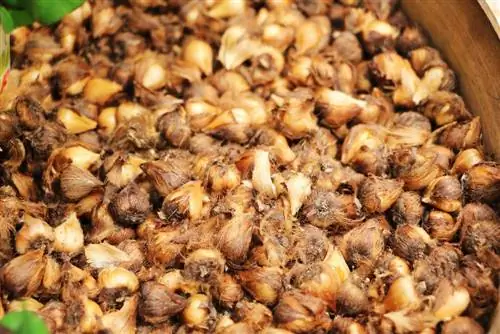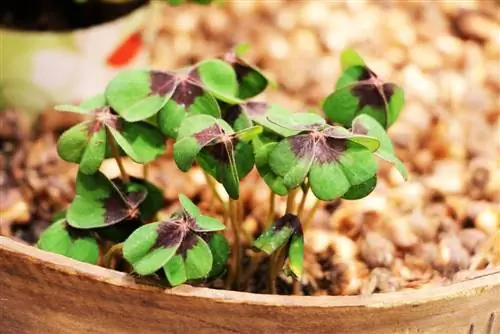- Author admin [email protected].
- Public 2023-12-17 03:39.
- Last modified 2025-01-24 12:45.
The lucky clover plants - botanically Oxalis tetraphylla - are found in large numbers in stores, especially at the turn of the year. However, few people know about proper care. With the right knowledge, it is very easy to grow an impressively dense plant from a small specimen and even enjoy the delicate flowers.
Location
The lucky clover plant wants a bright location, but not warmth. For example, a window sill in a cooler room, such as the bedroom or hallway, is ideal. However, you don’t get the “heat” in the living room. In the garden or on the balcony it should not necessarily be in the blazing midday sun. Morning and evening sun or light shade in an airy and cooler location suits the lucky clover better. Temperatures between 10 and 15°C are ideal, but this is difficult to maintain both indoors and outdoors all year round.
Substrate
In contrast to choosing the location, deciding on a suitable substrate for the lucky clover plant is very easy - normal potting soil is completely sufficient. Alternatively, garden soil enriched with mature compost can also be used.
Tip:
The maintenance effort is reduced if fertilized substrate is chosen.
Sowing

Sowing the lucky clover plant is child's play. Seeds, some soil and water and a suitable location - that's all you need. The basic procedure is similar both indoors and outdoors and is as follows:
- When sowing in pots, care should be taken to ensure a very bright and warm location. The future growing place is chosen in the garden.
- A few seeds are planted at a close distance in a planter with potting soil, garden or potting soil or directly in the desired outdoor location and only lightly covered with substrate.
- The soil is moistened well or watered carefully. Growth can be accelerated in the pot by placing foil on it. This must be ventilated daily to prevent mold from forming.
- The soil is kept as consistently moist as possible in the first few weeks.
If the lucky clover plant is to be brought forward to decorate the garden or balcony next year, autumn is a good time for sowing. The young plants are already larger and more robust when they are released outdoors. When sowing directly outdoors, it should be noted that Oxalis tetraphylla is not frost hardy. Sowing should therefore take place in late spring after the last late frost.
Planting out
Pre-grown lucky clover plants are only planted outdoors after the last late frost due to the plants' sensitivity to sub-zero temperatures. There are no special features to consider here. The substrate from the cultivation container is carefully removed from the breeding tubers of the plants and placed in the soil at the desired location. This is followed by a light pouring.
Tip:
Care should be taken not to damage the tubers. Otherwise, mold or rot could form. It is therefore better to leave a little substrate on the bulbs than to clean them with greater effort.
Culture in pots
Since the lucky clover plant, as mentioned, is not frost hardy, it can only be cultivated as an annual plant when planted in the garden. Alternatively, it could be dug up in time for overwintering and brought inside. It’s different with culture in pots. Here, the four-leaf lucky clover can easily be perennial if cared for properly. However, it is also important to pay attention to a few factors:
- Good water drainage to avoid waterlogging
- No frequent location changes
- Make sure the location is cool
- Fertilize regularly
- Repotting if the container is too small
There are no high demands or special features with Oxalis tetraphylla.
Pouring
The lucky clover plant is watered with stale water as needed, if possible. That means always when the upper layer of earth has dried out. Watering can be reduced during wintering and during the dormant period from March to April. It is then only watered in such a way that the substrate does not dry out or only has a slight basic moisture content. When growing outdoors, watering usually only needs to be done during dry periods, whereas in pots, watering is continuous.
Fertilize

As mentioned, the care effort for the lucky clover is reduced by using fertilized or compost-enriched substrate - as additional fertilization in the first year is not necessary in these cases. There are then two options for nutrient supply. Either the lucky clover plant is repotted and the used substrate is replaced with fresh, nutrient-rich substrate.
Or from April to August, the lucky clover is supplied with a liquid flower fertilizer once or twice a month. Plant manure or untreated pond water can also be used outdoors instead. It is also possible to sprinkle a little mature compost around the plant.
Repotting and moving
The lucky clover specimens available on New Year's Eve are often in pots that are too small so that they appear particularly lush. This is one of the reasons why they often respond so quickly. Repotting can be the salvation here. However, it is often not necessary to move it, as the lucky clover is only one-year outdoors anyway.
When moving and repotting, the only thing that needs to be taken into account is that the underground breeding tubers are not injured. They are carefully lifted out of the ground and freed of substrate residues before they are inserted into fresh substrate and covered with it. The best time for the measures is between April and May - at the beginning of the growing season.
Propagate
The propagation of lucky clover can be done in two ways. On the one hand through the seeds, on the other hand through division. How lucky clover plants are propagated by seeds has already been described. The seeds can either be purchased commercially or obtained from flowering Oxalis tetraphylla if they produce fruiting bodies after the flowers.
Propagation is faster and easier via division. Lucky clover forms the underground breeding tubers already mentioned. These storage organs are developed by the plant itself in increasing numbers, which is why the four-leaf lucky clover can spread throughout the garden in a relatively short time and can even become a pest without appropriate intervention.
If this effect is to be used specifically, individual tubers can be carefully removed during repotting or moving and planted individually. Nothing more is necessary to propagate the lucky clover plant in this way. The daughter plants can be cared for directly in the same way as the older mother plant.
Wintering
Although the lucky clover itself is quite robust and can spread quickly in warm winter areas, it is sensitive to frost and must be protected accordingly. Plants that have spent spring and summer outdoors are therefore brought indoors at the end of summer or at the beginning of autumn. Here they should ideally be kept at temperatures between 10 and 15°C and brightly.
Oxalis tetraphylla planted outdoors must be dug up in autumn or late summer and brought indoors if they are to survive the winter. Here they can be cared for in a planter as described above or just the tubers can be overwintered without soil. But then at around 5°C, in a dry, dark room.
The following points should be noted in both cases:
- Stop fertilization in August or September at the latest
- Ensure a cool but frost-free location
- Continue watering, but more sparingly
Here too, the lucky clover once again shows its easy-care and undemanding side.
Diseases, pests and care errors

The lucky clover is not sensitive to diseases and pests; they are only found on the plants in the rarest of cases. However, care errors are very common.
A typical problem is choosing the wrong location. Oxalis tetraphylla needs a lot of light and low temperatures - but often ends up in a rather dark corner in the warm living room. The result is usually the initial development of weak, long and soft shoots. The plant begins to appear thin and weak overall and usually loses leaf color. Placing them on a cool window sill has a preventative and saving effect.
Other comparatively common mistakes in the care of lucky clover are:
- Waterlogging due to insufficient water drainage
- Lack of water supply
- Spent soil or lack of fertilization
- Too small planter
- Freezing due to being brought into the house too late
If the lucky clover plant grows weakly, develops long shoots or the lush leaf green lightens or appears pale and yellowish, these factors should be checked urgently. If you intervene in time, the plants can usually be saved.
Conclusion
The lucky clover plant is an easy-to-care plant that is a decorative addition as a pot plant and in the garden thanks to its quartered leaves and lush growth. As long as it has a sufficiently bright and cool location, some water and nutrients available, it will even reward your care with decorative flowers.






